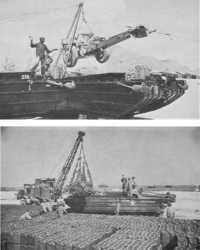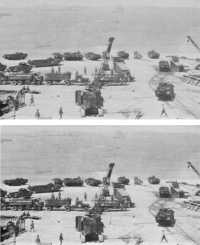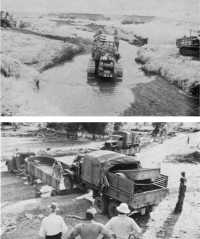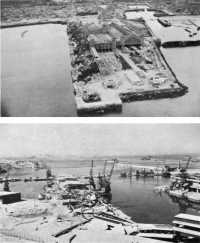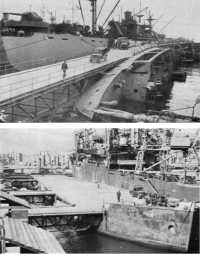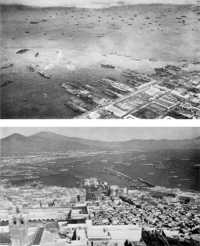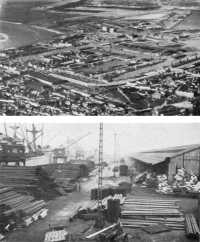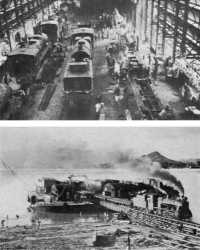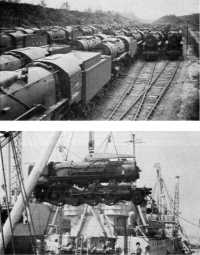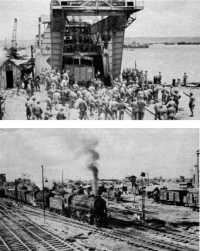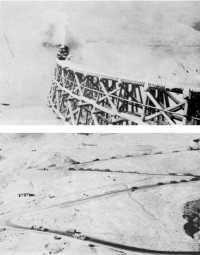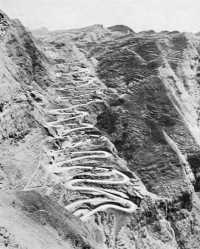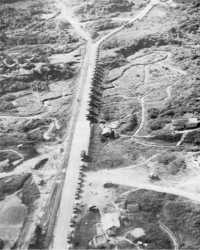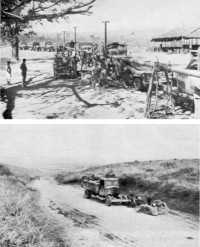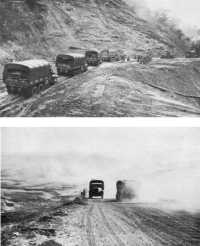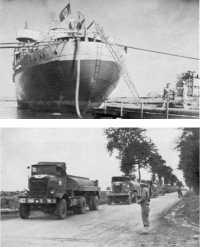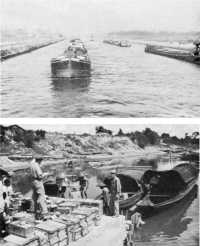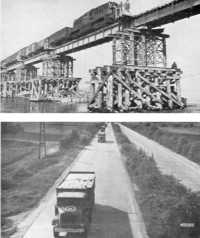Illustrations
Movement of troops to and within overseas areas was one of the important Transportation Corps activities. Troops aboard ship (top); RTO, a familiar figure at overseas rail terminals (bottom).
The versatile DUKW being used in training at the Waimanalo Training Center, Hawaii (top), and at Slapton Sands, England (bottom).
DUKWs in use in ship-to-shore movements on the beach at Cherbourg, France (top), and off Bougainville (bottom).
Note: These two photographs are identical in the original printed book.
Ingenious use of terrain features by individual units facilitated the delivery of supplies and equipment. The gravel bed of a stream used as a road when equipment hogged down in the tundra on Attu (top), and a roadside hank used as a loading ramp in Australia (bottom).
Widespread destruction of facilities at major European ports hampered transportation operations. Ships were scuttled in an effort to make rehabilitation of the ports difficult. Typical were Cherbourg (top) and Marseille (bottom).
Sunken ships in the harbor at Naples converted into piers for the berthing of Allied ships.
Port congestion from Manila (top) to Naples (bottom) caused a serious shortage of available bottoms.
The port of Antwerp. Captured virtually intact, Antwerp (top) became a major port of entry for cargo. Soon, more cargo was discharged (bottom) than could be immediately transported inland.
MRS operations in India. Overhauling equipment in the shops at Saidpur (top), and breaking bottlenecks at such points as the Amingaon–Pandu Ferry (bottom).
Rail equipment was stored on sidings in Great Britain (top) before the invasion of Europe, and ferried to France (bottom).
Rail equipment arrived in France (top) and was put into service over the repaired tracks of the continental rail systems (bottom).
Climatic extremes encountered and overcome. Supplies and personnel were moved through heavy snow in Alaska and Western Canada (top) and over the arid mountains of Iran (bottom).
Overland movements east of Kunming were hampered by rugged terrain features. Note road with twenty-one switchbacks at An-nan, China.
Convoys for China were sent from Ledo, Assam, over the Stilwell Road to Kunming, China.
Truck refueling Station on the Ledo Road at Myitkyina. New equipment delivered to China replaced old, worn out vehicles that frequently had to be repaired on the road.
Road conditions in Burma (top) and Iran (bottom). During the monsoon periods in Burma mud delayed deliveries. In Iran dust storms caused similar delays.
Delivering the goods by captured Italian tanker directly into a pipeline at Naples (bottom), by the Red Ball Express in France (top).
Delivering the goods by barge on the Albert Canal in Belgium (top), and by sampan at Chinkiang, China (bottom).
Support of the final offensive against Germany included rail and truck movements across and beyond the Rhine. The first train moved over the Wesel Bridge (top) on 9 April 1945; 10-ton semitrailers of the Yellow Diamond Express, with supplies for the Seventh U.S. Army, on an autobahn (bottom).

